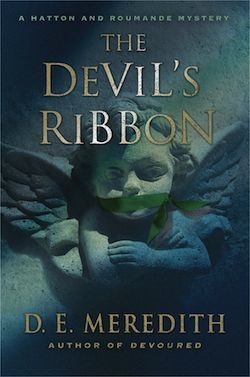
This is Meredith’s second novel, which also features her ongoing characters, Professor Adolphus Hatton and his morgue assistant, Albert Roumande. These books are set in the very early days of forensic science and all the more interesting because of it. It’s fascinating to read just how much they were learning every day.
I enjoyed the relationship between Hatton and Roumande. Their lives are very different—Hatton is a bachelor and Roumande has a wife and daughters—yet the two scientists meld together beautifully in the lab or at the scene of a crime. They complement each other in every way and provide a great view of what’s going on for the reader.
How Roumande had secured this magnificent microscope, Hatton didn’t know and he didn’t care to know, as it cost more than half their yearly income. Nut brown and polished to a shine, the instrument was left standing on its own special table, to be used only in matters of forensics.
Hatton peered down the lens of the Spencer, his fingers curling around the viewing rods, the instrument astounding him with its precise and extraordinary clarity, leaving little room for doubt. The mucosa was clear of any fever, but the gut samples would take a little more scrutiny.
“The Marsh Test, Professor?”
“Yes, Albert. Bring me the Bunsen burner.”
Grey was intrigued, for it was well known that this method was reserved for detecting traces of arsenic only. He watched mesmerized, as Hatton selected a glass test tube in the shape of a capital U and, using a dropper, added a little sulphuric acid and a gram of zinc and, with steady hands, took a tad of the gut muscle and dropped it into the tube. Roumande lit the Bunsen, the blue flame illuminating a small plate, which the chief diener held up as if it was a mirror. Grey hovered, Patrice not far behind, as Hatton held the tube as close as he could to the plate, and then after a count of, “Are you ready, Professor? Un . . .deux . . . trois . . .”
Hatton pulled the stopper out, like a champagne bottle. Instantly, the gas revealed itself against the gleaming white, like a miniature storm cloud, which was not the shiny black of arsenic, but sepia.
In the midst of a cholera epidemic, Hatton and Roumande are called in to help Scotland Yard’s newest star, Inspector Jeremiah Grey. Hatton takes an immediate dislike to Grey, who is at best a dandy and a fop and at worst, willing to do whatever it takes to solve his crime, whether it’s good means or bad. He also hates the Irish, which Hatton finds appalling.
Hatton and Grey, who are so opposite from each other, are thrust into the battle lines in London, trying to sort out the war between the English and the poor, desolate Irish immigrants. Hatton and Roumande first deal with the Irish through the cholera that has stricken so many of the city’s poor. When they have to examine the body of a beautiful little girl, it leaves Hatton feeling melancholy surrounded by memories of other deaths he had no way to stop.
Another reason this book was enjoyable was Hatton’s humanity. While he’s following the cynical Inspector Grey around London looking for a murderer, he’s overcome with sorrow for the plight of the Irish—the places they live, the way they struggle, their pride in their country even though they were forced to leave it.
Yes, he took the point, because Hatton knew this man. Gabriel McCarthy MP was an Irish Unionist and so considered a friend of the British. The two countries had been forged into one, the Act of Union, described in The Times as a “delightful marriage” but viewed by many as nothing less than a rape. Emancipation for Catholics was promised but not given, rebellions were quelled with the gun. The Unionists vaguely talked of Repeal but only by legitimate means. But these moderates were the Old Men of Ireland with their aristocratic manners and respect for the Queen. Secret societies with names like The Oak Boys, The White Boys, and Ribbonmen had long since gathered in the bogs and glens of Ireland plotting revenge, but now they had morphed into a hiss on the streets of St. Giles, Whitechapel, Soho, Southwark, Saffron Hill— a hiss of Gaelic—Fenians.
It’s obvious Hatton feels their pain, even though he understands the workings and reasoning of his own government. He looks at the world through a healer’s eyes, and that often means he’s at odds with those around him, which makes him more interesting and very entertaining.
Meredith adds another element to Hatton’s confusing days by putting in his path the lovely Sorcha McCarthy. She is the gentle, determined wife of one of the murdered, who captures Hatton’s heart with her intelligence and beauty. Not only does she have the grace and elegance of a wellborn wife, she has scientific knowledge and, like Hatton, longs to learn more.
So there you have it, all the ingredients for a wonderful read—puzzling murders, tumultuous times, a cast of fascinating characters, and a little romance to add sweetness. As for me, I’m going to go back and read the first book and keep an eye out for the publication of the next one.
Leigh Neely is a former newspaper and magazine editor. She currently does freelance work and recently had a short story published in the anthology Murder New York Style: Fresh Slices and is a contributor to the blog WomenofMystery.net.

Thanks Leigh. I just put the first book on my to be read pile.